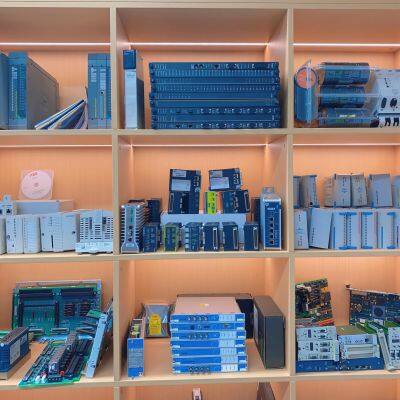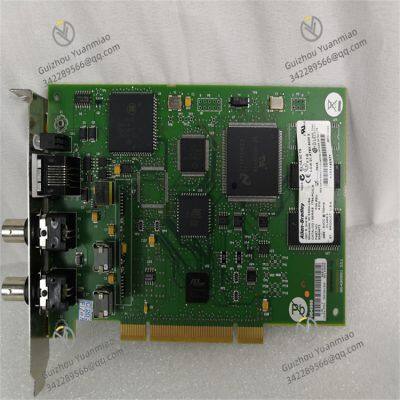Product Description
I. Product Overview
1784-PCIC is a ControlNet universal PCI communication card that plays a vital role in the field of industrial automation communication. Leveraging Rockwell Automation's profound technical heritage and rich practical experience in industrial control, 1784-PCIC is committed to building an efficient and stable data interaction bridge for industrial systems, facilitating the smooth progress of various automation projects, and becoming a powerful assistant for many industrial enterprises to achieve intelligent production.
This product is originally produced in the United States, and the entire manufacturing process follows Rockwell Automation's extremely strict quality control system. From the initial careful selection of components, to the precise assembly during production, and then to the comprehensive inspection of finished products, every link is pursued with excellence, striving to maximize the product's quality and reliability. In today's global industrial trade environment, through core domestic ports such as Shanghai, Shenzhen, and Tianjin, 1784-PCIC can be transported to all parts of the world conveniently and efficiently, timely meeting the urgent needs of industrial enterprises in different regions for advanced communication interface equipment, and injecting strong impetus into the upgrading and improvement of global industrial automation communication networks.

II. Technical Parameters
(1) Communication Capability
Interface Type:
As a PCI card, 1784-PCIC strictly complies with the PCI Revision 2.2 standard and is fully compatible with 5V and 3.3V PCI slots, 32-bit and 64-bit PCI slots, and PCI-X slots. However, it should be particularly noted that it is not compatible with PCI Express and must not be inserted into a PCI Express slot to avoid equipment damage. Its standard PCI interface design lays a solid and stable physical connection foundation for devices to access the industrial network, ensuring unimpeded data transmission channels.
It is equipped with a dedicated RJ-45 connector as the network access port, paired with a 1786-cp cable (RJ-45 8-pin connector), mainly used to connect ControlNet network devices and programming terminals. This connection method can effectively ensure the stability and efficiency of the data transmission path, enabling fast and accurate data interaction between the programming terminal and network devices.
It also has 2 redundant media BNC connectors, which can be directly connected to the ControlNet network. In the complex and ever-changing industrial network environment, the redundant design greatly enhances the reliability and redundancy of communication. Even if one connection is abnormal, the other backup connection can quickly take over, ensuring the continuity of data transmission and avoiding production interruptions due to network failures.
Communication Protocol Support: It fully supports the ControlNet communication protocol, which enables it to achieve seamless docking and efficient communication with various devices that meet ControlNet standards, such as PLC-5 series programmable controllers. Whether it is real-time monitoring of equipment operating status or accurate transmission of complex control commands, 1784-PCIC can play a key role in the industrial automation communication architecture by virtue of its in-depth support for the ControlNet protocol, completing various data interaction tasks accurately and quickly.
(2) Data Processing Performance
Processor Collaboration Performance: Through a specific on-board mechanism (similar to the technical principle of dual-port memory), 1784-PCIC achieves efficient data interaction with the host processor. This design can effectively avoid potential bottlenecks in the data transmission process, allowing the host processor to obtain the data collected or received by 1784-PCIC in a timely manner, and at the same time, promptly feed back the processed control commands to 1784-PCIC for subsequent data transmission. In this way, the data processing process of the entire industrial automation system runs smoothly, and the response speed is significantly improved, providing strong support for the efficient and stable operation of the production process.
Data Transmission Management Capability: 1784-PCIC itself has powerful data transmission and management functions. In the industrial network environment with large and complex data traffic, it can systematically classify a large amount of data accurately, package them quickly, and transmit them to the target devices or systems without error. Moreover, this product also has a local network real-time diagnosis function. Once abnormal conditions such as signal attenuation and packet loss are detected in network communication, it can quickly locate the problem and feed back to relevant personnel in a timely manner, providing key basis for maintenance personnel to quickly troubleshoot and solve network faults, and greatly improving the maintenance efficiency of the industrial network.
(3) Environmental Adaptability
Operating Temperature Range: It can operate stably within the temperature range of 0°C to 50°C (32°F to 122°F). Whether it is an industrial plant in a frigid region or a production workshop in a hot environment, 1784-PCIC can cope with ease, ensuring that it performs communication duties normally under different temperature conditions, and that the stability and accuracy of data transmission are not affected by temperature fluctuations.
Storage and Transportation Temperature: During storage or transportation, the ambient temperature must be maintained between -40°C and 85°C (-40°F to 185°F). This wide temperature adaptation range enables the product to effectively maintain the stability of internal electronic components in various complex logistics and warehousing environments, ensuring that all performance indicators of the product are not affected when it reaches the user, providing a reliable user experience.
Relative Humidity: It can work reliably in an environment with a relative humidity of 5% - 95% (non-condensing). In a humid environment, its internal circuits and components have undergone special moisture-proof and anti-corrosion treatments, which can effectively avoid faults such as short circuits and corrosion caused by moisture; in a dry environment, through electrostatic protection design, it can effectively prevent static electricity from damaging the equipment, thus ensuring that the product can operate stably for a long time under different humidity conditions.
Vibration Resistance: In accordance with IEC 60068-2-6 (Test FC, operating) standard, the vibration rating of 1784-PCIC is 2g @ 10-500Hz. In industrial sites, continuous vibration generated by the operation of various mechanical equipment is a common phenomenon. With its excellent anti-vibration design, 1784-PCIC can work stably in such a vibration environment, ensuring that the communication connection remains stable and data transmission is not disturbed, providing a guarantee for the continuity of industrial automation production.
(4) Power Supply Requirements
During operation, 1784-PCIC requires a specific power supply to provide stable electrical energy support. Specifically, a 5V DC power supply is needed to supply a certain current (such as 640mA mentioned in some materials) to maintain its normal operation. The power input design has good stability and compatibility, and can adapt to voltage fluctuations within a certain range, ensuring that 1784-PCIC can still stably obtain the required electrical energy and continue to work normally in complex and variable industrial power supply environments. At the same time, the product is integrated with overvoltage and overcurrent protection circuits. Once an abnormal power supply situation occurs, the protection circuit will automatically activate to avoid irreversible damage to the equipment due to power supply problems, greatly improving the safety and reliability of the equipment.

III. Functional Characteristics
(1) High Reliability Communication
1784-PCIC adopts industrial-grade high-quality components and uses advanced circuit design concepts, endowing itself with extremely strong anti-electromagnetic interference capability. In industrial sites, a large number of motors, frequency converters and other equipment will generate strong electromagnetic interference when operating, and 1784-PCIC can effectively resist external interference in such a harsh electromagnetic environment, ensuring the accuracy of data transmission and the reliable execution of control commands. Whether it is high-rate data transmission tasks or long-term continuous communication operations, it can always maintain a stable operating state, greatly reducing the probability of communication interruptions, data errors and other problems caused by electromagnetic interference, and laying a solid foundation for the stable operation of industrial automation systems.
(2) Flexible Network Connection
It can serve as a key node on the ControlNet network, directly connecting to PLC-5 and other series of controllers, and also has the ability to communicate with various different series of processors. This flexible and diverse network connection feature gives industrial automation systems a high degree of freedom in equipment selection and network architecture construction. Enterprises can easily build personalized industrial communication networks according to their own unique production needs and existing equipment configurations, without worrying about compatibility issues between devices, thereby achieving optimal allocation of resources and improvement of production efficiency.
(3) Convenient Installation and Configuration
In the product design stage, full consideration was given to the convenience of installation and configuration. Before installation, users only need to simply configure the relevant settings of the card (such as interrupt settings and basic memory addresses), and then can smoothly install it into the compatible PCI slot. The entire operation process is simple and easy to understand, without complex professional debugging procedures, which greatly shortens the equipment installation and debugging cycle and significantly improves the implementation efficiency of the project. However, it should be noted that because 1784-PCIC is designed based on specific technologies (such as CMOS technology), it is more sensitive to static electricity. Therefore, during operation, users must strictly follow standard ESD (electrostatic discharge) protection measures, such as touching grounded objects to release static electricity before operation, wearing a grounded wristband, avoiding direct contact with connectors and components, etc., to effectively avoid static electricity damage to the equipment. When the equipment is not in use, during transportation and repair, placing it in an electrostatic shielding container can further ensure the safety of the equipment.
Allen-Bradley 1784-PKTX Network Interface Card
Allen-Bradley 1797-PS2E2 FLEX Ex Power Supply Module
Allen-Bradley 2094-BC04-M03-S Kinetix 6000 Integrated Axis Module
Allen-Bradley 2094-BM01-S Class Axis Module
Allen-Bradley 2094-EN02D-M01-S1 Kinetix 6200/6500 Control Module
Allen-Bradley 2098-DSD-020X Ultra 3000 Digital Servo Drive


Allen-Bradley 5204-DFNT-PDPMV1 EtherNet/IP Communication Module
Allen-Bradley 5302-MBP-MCM4MB EtherNet/IP Communication Module
Allen-Bradley 80026-044-06-R Power Supply
Allen-Bradley 80190-300-01-R Original Packaging Module
Allen-Bradley 81001-450-53-R Circuit Board
Allen-Bradley 80190-580-01-R Drive Processor Module
Allen-Bradley 81001-340-71-R High-Performance PLC Module
Allen-Bradley 81007-465-51-R Voltage Sensing Board
Emerson 1C31194G04 Valve Positioner Module
Emerson A6110 9199-00001 AMS Shaft Relative Vibration Monitor
Emerson A6120 9199-00002 Relative Vibration Monitor
Emerson A6140 9199-00058 Relative Vibration Monitor
 yezi
Hi there! Welcome to my shop. Let me know if you have any questions.
yezi
Hi there! Welcome to my shop. Let me know if you have any questions.




